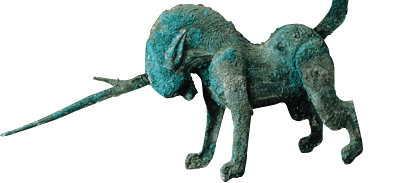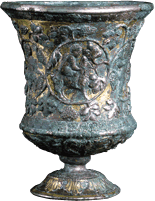| Unicorn Late Han dynasty Excavated from Tomb 18 of Xiaheqing, Jiuquan, Gansu Province Gansu Provincial Museum |
 |
|
 |
||

Gold
Western Jin to Northern Dynasties period
Excavated at Darhan Mumingan Banner, Ulanqab League,
Inner Mongolia Autonomous Region
Inner Mongolia Autonomous Region Museum
Colored ceramics
Northern Wei Dynasty
Excavated from the Song Shaozu Tomb,
Datong, Shanxi Province
Datong City Institute of Archaeology

Stem Cup with Putti
and Grapevine
Gilt bronze
Late 4th century
Excavated Datong, Shanxi Province
Datong City Museum
and Grapevine
Gilt bronze
Late 4th century
Excavated Datong, Shanxi Province
Datong City Museum
